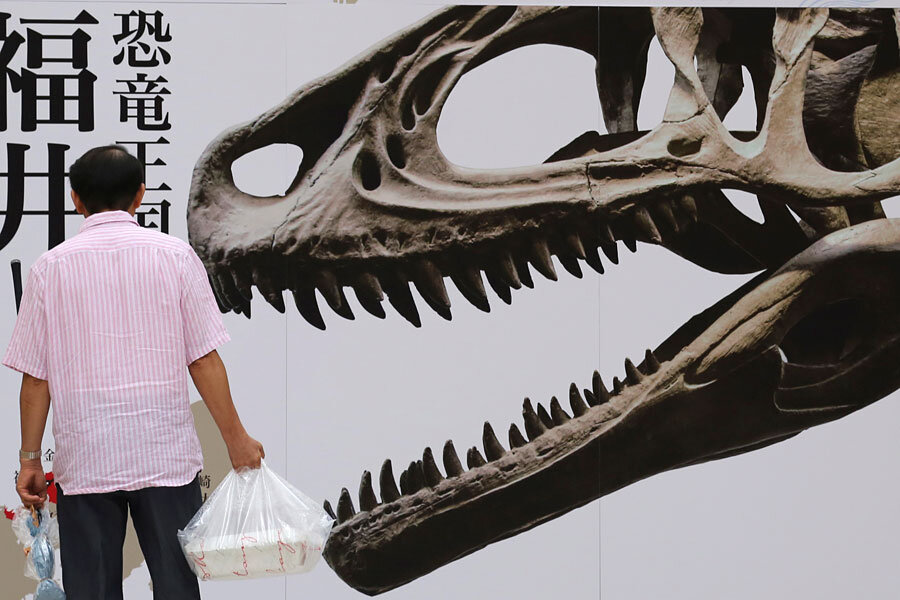If it weren't for that meteor, would there still be dinosaurs?
Loading...
New research suggests that non-avian dinosaurs were driven to extinction not just by the six-mile wide asteroid that slammed into our planet some 66 million years ago, but by a number of other environmental threats.
Between intense volcanism, dramatic sea level changes, and fluctuations in temperature, the dinosaurs' world at the end of the Cretaceous period was far from idyllic.
But could the planet's instability have done in the dinosaurs all on its own? Probably not, researchers say.
About 400,000 years before the asteroid came crashing into our planet, massive volcanic eruptions began in India, prompting rapid global climate change. This, combined with dramatic ecosystem changes, may have weakened the non-avian dinosaurs. But, say researchers in a study published this week in Biological Reviews, it was the massive space rock that delivered the fatal blow.
"Dinosaurs had been around for 150 million years. Their diversity was always changing. There were plenty of dips in their diversity over time, and they always recovered," says study author Steve Brusatte, a paleontologist at the University of Edinburgh. This time would have been no different, "I'm sure they would've recovered if they'd had more time."
A worldwide disaster
The asteroid crashed into the Yucatán Peninsula at about 45,000 miles an hour, with enough force to top 100 million atomic bombs.
After the impact, the Earth's surface was nearly barren. Dust covered much of the region around the impact site. Within a few hours, Richter-scale-breaking earthquakes and a 650-foot tsunami devastated the Caribbean.
Dirt, water, and the vaporized remains of any living things near the impact site hurtled upward to the edge of space, and then fell back to Earth, prompting a heat wave that caused trees worldwide to spontaneously burst into flames.
Then came a period of cooling. Ejecta filled the sky, blocking photosynthesis and killing plants. Since the impact site was rich in sulphur, this effect was exaggerated in the upper atmosphere. In the lower atmosphere, this ejecta produced acid rain.
Most dinosaurs would have died from the heat. But animals that survived that fateful day struggled through the following weeks and years. About 70 percent of all life went extinct.
What if the asteroid never hit?
"It would be a different world," says Sean Gulick, a geologist studying the impact crater at the University of Texas Jackson School of Geosciences. "If there hadn't been this impact, [the dinosaurs] might have just kept on going."
"The dinosaur story is really our story," says Dr. Brusatte. The extinction of dinosaurs left a gap to be filled. Although some mammals died out in the mass extinction, enough made it through, and the Earth entered the Age of Mammals.
"If dinosaurs didn't go extinct, mammals probably would've remained in the shadows, as they had been for over a hundred million years," says Brusatte. "Humans, then, probably would've never been here."
But Dr. Gulick suggests the asteroid may have caused less of an extinction had it hit a different part of the planet. If it had hit a less-sulphur-rich location, lower in carbon dioxide, like, say, the middle of the Canadian shield, he says, the ejecta released may have been less toxic.
But what does all this mean for our world?
Brusatte says the dinosaurs were probably weakened by a changing climate. Although today's Earth does not see dramatic volcanism like that of the dinosaurs' era, the climate is changing, and sea levels are rising.
"If an asteroid hit today, we'd be in huge trouble," says Brusatte. Although he hopes humans will develop the technology to divert an incoming asteroid, "It will happen again. A lot of asteroids hit the planet over time."
"It would not be a nice thing to have to endure. Especially because our world is losing a lot of diversity these days," says Brusatte. "I think the dinosaur record shows that if you lose diversity, things can be even worse when a big catastrophe happens."






